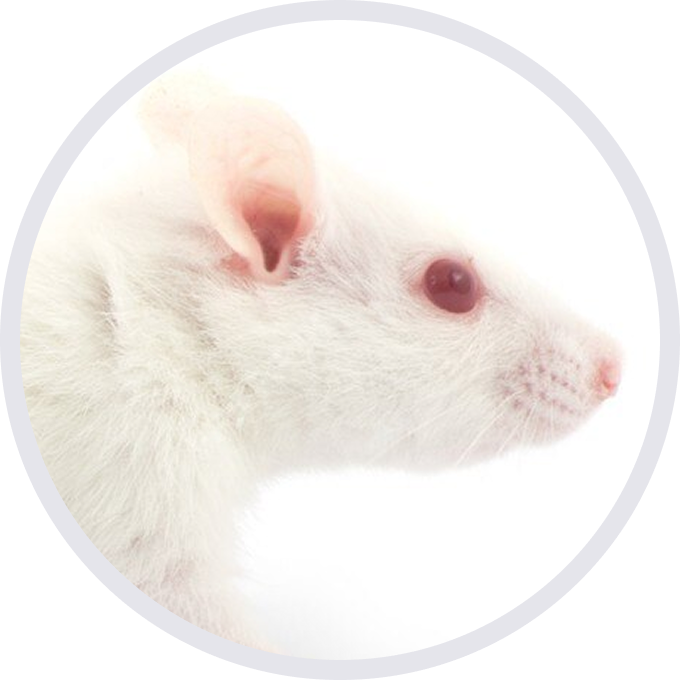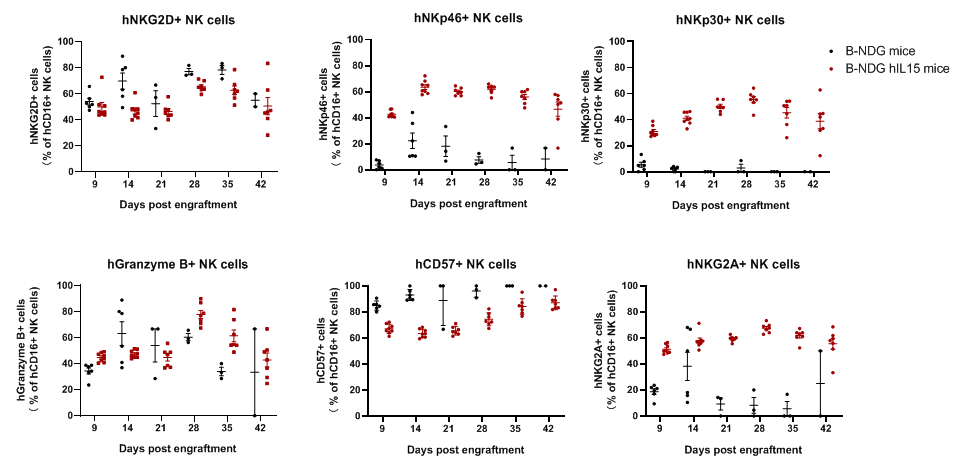


NOD.CB17-PrkdcscidIl2rgtm1BcgenIl15tm1(IL15)Bcgen/Bcgen • 112482
| Product name | huNK-B-NDG hIL15 mice |
|---|---|
| Catalog number | 112482 |
| Strain name | NOD.CB17-PrkdcscidIl2rgtm1BcgenIl15tm1(IL15)Bcgen/Bcgen |
| Strain background | B-NDG |
| Aliases | IL-15 |
| Application | Promote differentiation of human NK cells |

Expression analysis of functional markers and surface receptors in reconstituted human NK cells. NK cells were purified from human PBMC using the sorting kit, and sorted NK cells (2.0 M) were intravenously injected into B-NDG mice(female, 6-week-old, n=7)and B-NDG hIL15 mice(n=8)after treated with 1.2 Gy irradiation. Peripheral blood was collected weekly to detect cytotoxic markers Granzyme B and CD57, cell surface agonistic receptors NKG2D, NKp46 and NKp30, and the cell surface inhibitory receptor NKG2A in human NK cells. Results showed that compared with B-NDG mice, the proportions of hNKp46+ cells, hNKp30+ cells, Granzyme B+ cells and human NKG2A+ cells in B-NDG hIL15 mice after human NK cell reconstitution were significantly increased, while the proportions of hNKG2D+ cells and hCD57+ cells were slightly decreased. These results indicated that the reconstituted human NK cells have cytotoxic activity.

Engraftment of human NK cells in B-NDG hIL15 mice enhanced the reconstitution of human NK cells. Female 6-week-old of B-NDG mice (n = 7) and B-NDG hIL15 mice (n = 8) were irradiated with 1.2 Gy, and NK cells (2E6) obtained after purification of human PBMCs were intravenously injected. Peripheral blood was taken weekly to analyze the reconstitution level of human immune cells. The results showed that the proportion of NK cells obtained from PBMC purified reached 80%. Compared with B-NDG mice, the number and proportion of reconstituted human NK cells (CD3-CD56+) were significantly higher in B-NDG hIL15 mice. The proportion of NK cells remained around 80% after 2 weeks of reconstitution and a higher proportion of NK cells remained after 6 weeks of reconstitution. Reconstituted human NK cells were predominantly CD16+ NK cells with cytotoxic activity.

Antitumor activity of anti-human CLDN18.2 antibody in lung cancer cell line A549 CDX model established with huNK-B-NDG hIL15 mice. Human NK cells (2E6) purified from PBMCs were intravenously engrafted into B-NDG hIL15 mice irradiated with X-ray. B-hCLDN18.2 A549 cells (1E7) were subcutaneously inoculated into B-NDG hIL15 mice. The mice were grouped when the tumor volume reached approximately 100-150 mm3 at which time they was treated with anti-human CLDN18.2 antibody (zolbetuximab, in-house) with dose and schedule indicated in panel (n=6). Peripheral blood was collected weekly to analyze the reconstitution levels of human CD45+cells and NK cells. The results showed that zolbetuximab could effectively inhibit tumor growth in huNK-B-NDG hIL15 mice. High levels of human NK cells could be detected in peripheral blood.